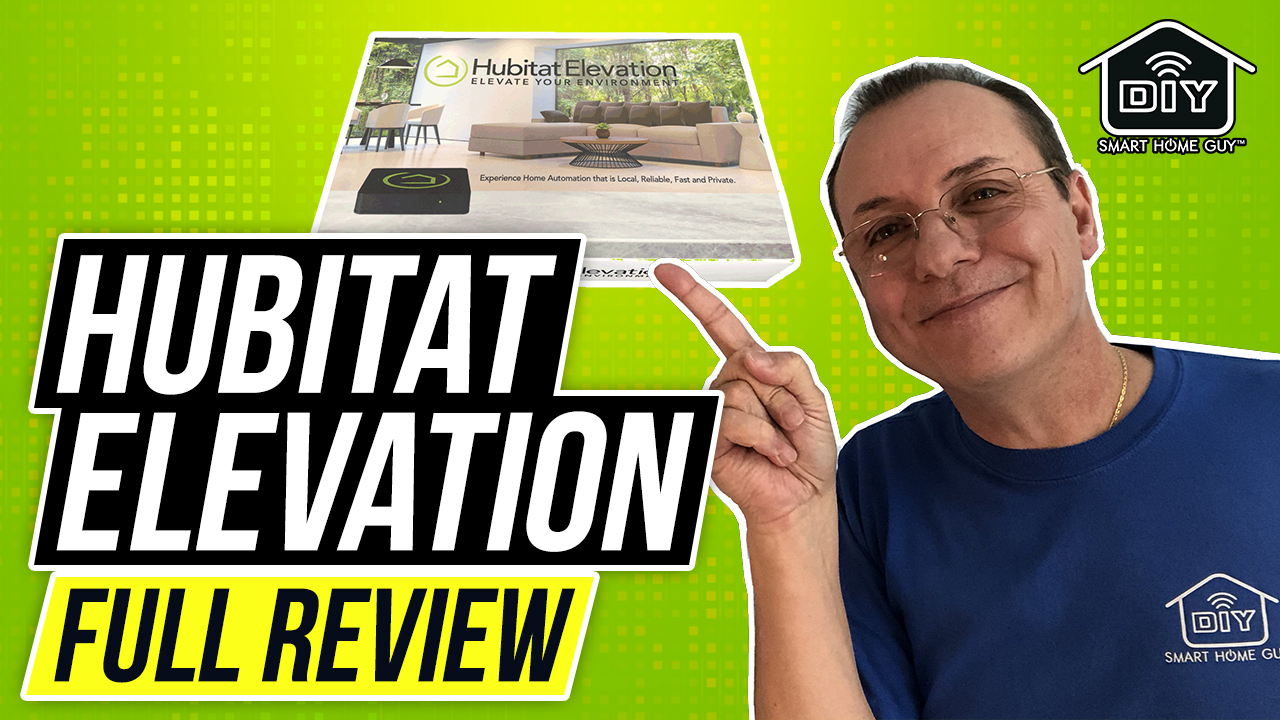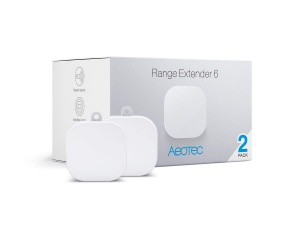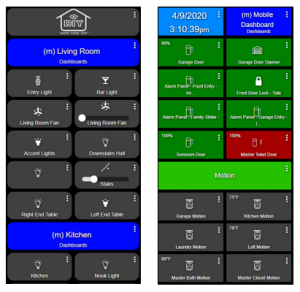Hubitat Elevation Gen C5 Smart Home Automation Hub Review

The Hubitat Elevation Smart Home Automation hub is the new little darling of the home automation enthusiast. But is it good for the normal human just trying to jump into the home automation world. Discussing hubs amongst smart homers can quickly turn into a religious war. Well, I don’t intend to do that here. This video is my honest review of the Hubitat Elevation as I first discovered it, the good and the bad.
 |
Hubitat Elevation |
 |
Aeotec Range Extender 6 |
Overall Rating
Hubitat |
Hubitat Elevation is incredibly powerful and if you don’t mind a bit of a learning curve, it’s a no brainer. Hubitat is highly configurable, which can make it intimidating. There is a requirement that you roll up your sleeves and dig in. There is great community support and a vast array of community developers which make more and more cool stuff available all the time. In all honesty, once you figure out what their doing, it’s not really that hard to figure out. In fact, the overall user experience is pretty simplistic.
The complexities that you run into are centered around trying to do more complex automations, which makes sense in a way. You wouldn’t have even known you could do some of these things on a simpler hub.
I’ve played around with SmartThings, Wink Hub 1 & 2 and Vera. To be honest I find myself less frustrated with the Hubitat than any other hub. Wink is by far the simplest to use, but it is the least powerful of the four. SmartThings has a simple side and a complex side. The simple side is slightly more complex than Wink, the complex side is only overshadowed by Vera. For all that you can do with Hubitat, it truly deserves a serious look.
Device Support
Hubitat |
This can be very subjective. If one hub supports all your devices and the other doesn’t, you’d feel one hub was superior. The key here is ‘your devices’.
Rather than focus what works with my hub or your hub, I’ll look at this from the approach to devices, since it’s different than most other hubs (with the exception of SmartThings).
Hubitat Supported Devices Approach – Hubitat tests many devices, but I don’t think (not sure) they charge for the addition of new handlers. My understanding is that they try to enhance their generic drivers to accommodate new devices rather than make specific drivers. This is clearly not always the case when you look at their driver list. If they have not tested a device and the generic drivers don’t work, Hubitat encourages community created drivers. This allows users to load drivers for devices that Hubitat doesn’t natively support. I can say that I have several of these on my system and they work great. As one might expect, Hubitat does not support community drivers, so they are use them at your own risk.
List of Compatible Devices – Hubitat Documentation
Lutron Caseta Support
Hubitat |
Hubitat does not have a built in RA2 radio, but you’re not completely out of luck. Hubitat has a Lutron Integrtor app which allows you to purchase a Lutron Smart Bridge Pro (P/N L-BDGPRO2-WH) to link the all together. And since it’s a local connection (not through the cloud) it’s lightening fast. The downside is that the Smart Bridge Pro retails for ~ $100.
Mobile App
Hubitat |
This is another area that is difficult to compare due to the opposite approaches taken by hub manufacturers. So rather than compare them head to head, again we must judge them based on their approach.
Hubitat Mobile App Approach – Hubitat has taken a nearly 180 degree stance (compared to other smart home hubs) on the purpose of the mobile app. You can only interact with dashboards and geofencing. As we’ll discuss later, Hubitat dashboards are very powerful so, from this perspective, it’s really more of a positive than a negative. The geofencing is also very cool and allows you to use your phone as a presence detection device.
If you’re looking for logs or home automation rule setup from the mobile app, you’re out of luck (well, mostly). There are work around’s for this, but I wont go into them here. Perhaps one day I’ll make a video.
According to Hubitat, they took this approach on purpose. The idea is that this is a true home automation hub and you should try to minimize the amount of time that you rely on devices like the Amazon Echo, Google Home Assistant, and your smart phone to control your home. If you need control, you can do it from custom dashboards that are optimized for the user experience.
Desktop App
Hubitat |
On the Hubitat side, the desktop app is all encompassing and has a mobile factored user interface. The only drawback is that you can only access the desktop app (even from the mobile device) while you’re on the same network as your hub. This is a nice security feature. As stated earlier, there are work around’s to let you access your hub while outside your home network, but I wont cover those here.
A negative side of the Hubitat user interface is that it’s not very pretty and can be intimidating. It could really use a more modern graphical look and feel. You do get past this pretty quickly.
Stability & Local Control
Hubitat |
If you really want to understand the stability of a hub, join their respective Facebook groups. For Wink (and SmartThings for that matter), you will see weekly questions asking if anyone else is offline or experiencing the flashing blue light. Even though the Wink Hub does provide local control (mostly), it still has dependencies on their cloud servers.
Hubitat is fully local. Other than the cloud served dashboards that is. If the Hubitat cloud goes down, you will still have access to all of your automations from your home, everything will still function, your dashboards are still available inside your network. If you’re trying to access the dashboards while outside your home, no-go (except for the work around I keep refusing to talk about).
Hubitat does not force hub updates. With Hubitat you have the ability to download a backup of your hub before you run an update. If anything goes wrong, you simply load the backup. This is a great feature. If you replace hubs, all is not lost, you can import a backup and be up and running again. Vera also offers this capability by the way.
I gave Hubitat a minor hit on stability due to the community drivers aspect. It is not uncommon for a Hubitat user to install community drivers for unsupported devices and create havoc on their network. Such is the price of an open platform.
I mentioned watching the hubs Facebook group. The most common problem is a small percentage of people need to do daily reboots. My experience is that this is due to orphaned devices, chatty devices, bad Zigbee bulbs, etc. If (or when) you run into this problem, check your logs. This is most definitely not a hub problem, it’s a device problem. Remember all that power we talked about? This means it is possible for you to back yourself into a corner.
Automation Capability
Hubitat |
This is really where the Hubitat shines. Hubitat has levels of automation tools that provide capabilities for simple to complex automations. Before you ever get to the big daddy of Hubitat (Rule Machine), entry level users can start with the Hubitat Simple Automation app, Hubitat Motion Lighting app, Hubitat Mode Manager, Motion Lighting Apps, and Button Controller. These are in their own right far more powerful than Wink Robots. If those aren’t enough to pull off the impossible, Hubitat Rule Machine will get you across the line.
Admittedly with great power comes more complexity. It’s a standard trade. However Hubitat has a vibrant community that will help you as you go along.
Extensibility
Hubitat |
Hubitat, being an open platform, integrates with nearly everything. Okay, that’s a bit of a stretch. But it really is quite extensible. There is also the capability to add community apps, which is brilliant. SmartThings has a similar feature, but SmartThings custom apps and drivers run in the cloud, not local. With Hubitat, it all runs local.
The fact that Hubitat apps run local does mean that you may need to be careful with how much junk you go throwing onto our hub. But again, that’s a price you pay for flexibility and local control.
Dashboards
Hubitat |
As mentioned at the top of the article, dashboards are really the core of how you would interact with Hubitat on a day-to-day basis. They are all custom made by the user and have a wide array of formatting options.
The image below shows two different dashboards that we use on our phones. The image on the left is a main dashboard, and the image on the right is a room dashboard. Clicking on the blue header on the left dashboard loads the right dashboard.

Other Apps
Hubitat |
As for Hubitat, here is the current list of add-on applications that are built in.
- Chromecast Integration (beta)
- Ecobee Integration
- Hub Link (links two or more hubs together)
- Hubitat Safety Monitor
- Hue Bridge Integration
- IFTTT Integration
- Life360 Integration
- Lock Code Manager (very powerful – more capabilities than Wink lock manager)
- Lutron Integrator
- Maker API (allows connections to external endpoints)
- Mode Manager
- Ranchio Integration
- SharpTools (alternate dashboard engine)
- Sonos Integration
- Thermostat Scheduler
- Yeelight Integration
- Zone Motion Controllers
There are also community apps which further extent the capability of Hubitat. Even if Hubitat themselves didn’t think of it, there’s a good chance that the community did.
END